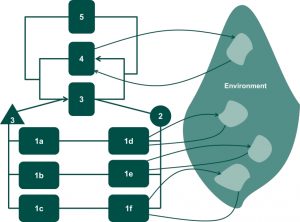
Managing in the face of complexity (part 4.6): Appropriate approaches – 6. Viable System Model (VSM)
This article is part 4.6 of a series of articles featuring the ODI Working Paper A guide to managing in the face of complexity.
This section [parts 4.1 to 4.8 of the series] outlines specific methods that can be used for managing in the face of complexity. Most of these approaches were originally developed in corporate business, where the shortcomings of centralised ‘command and control’ models were first noted, but have since spread into public sector management. These approaches are aligned with the general principles for managing complex interventions outlined … [in the previous parts of this series], but each has a specific focus and is tailored for particular circumstances or purposes.
6. Viable System Model (VSM)
This long-established method drawn from the cybernetics tradition identifies the core organisational requirements for social systems to be viable, i.e. sustainable and capable of development. It may be particularly useful for
decentralised management. It should enable organisations to reach optimum performance and adapt appropriately to context changes. VSM has three elements that interact: the operation system (that does the basic work), the meta-system (that holds the different units of the basic work together) and the environment (within which the system should remain viable).
Viability depends on the successful integration of five generic and interconnected systems present in every purposeful organisation1.

System 1 (‘day-to-day management’): the operational units that actually produce what the system is supposed to do (e.g. teams carrying out a specific task), in response to their environment (e.g. clients).
System 2 (‘coordination’): provides information, communication, and coordination processes for issues common to Systems 1 (e.g. monitoring systems, conflict resolution mechanisms, standards or rules for aligning the work of the operational units).
System 3 (‘control’): ensures that the practice of Systems 1 and 2 complies with the ‘policy’ functions of Systems 3 and 4 (e.g. performance monitoring; audit) and assures adequate resources in return.
System 4 (‘future development’): acts as an intelligence function that monitors the environment and helps to adapt and plan for the future.
System 5 (‘policy’): establishes policy in light of competing demands between the present and future and between internal and external perspectives.
VSM describes the information requirements and necessary interrelationships between these five systems. As a diagnostic tool as well as a design tool, it has been used in management for designing the distribution of tasks within an organisation, identifying appropriate information flows and specifying performance measurement issues. It is applicable for both non-profit and profit-making organisations, and can also be used to reflect public governance structures.
Next part (part 4.7): Appropriate approaches – 7. Capacity WORKS.
See also these related series:
- Exploring the science of complexity
- Planning and strategy development in the face of complexity
- Taking responsibility for complexity.
Article source: Hummelbrunner, R. and Jones, H. (2013). A guide to managing in the face of complexity. London: ODI. (https://www.odi.org/sites/odi.org.uk/files/odi-assets/publications-opinion-files/8662.pdf). Republished under CC BY-NC-ND 4.0 in accordance with the Terms and conditions of the ODI website.
Header image source: pxhere, Public Domain.
References:
- Espejo, R., Schuhmann, W., Schwaninger, M., & Bilello, U. (1996). Organizational Transformation and Learning: A Cybernetic Approach to Management. New York: John Wiley. ↩





